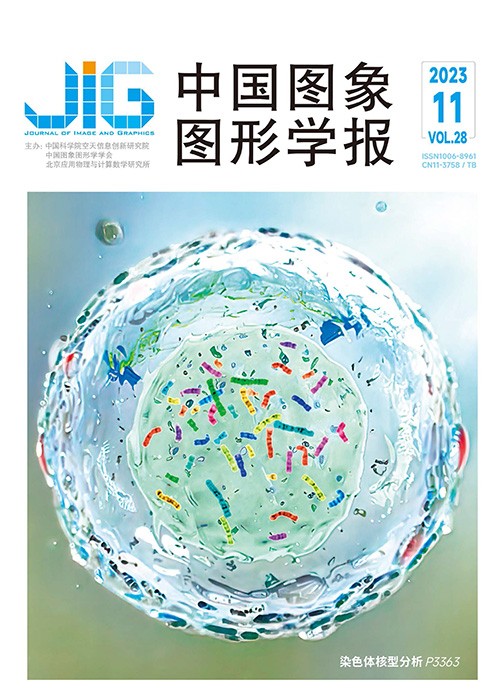
椭圆曲线与自适应DNA编码的混沌图像加密算法
摘 要
目的 当前大多数的混沌图像加密算法采用与明文相关的对称加密方式,存在密钥冗余以及一次一密模式难以实现的问题,为此,提出一种新的椭圆曲线与自适应DNA(deoxyribonucleic acid)编码结合的混沌图像加密算法。方法 算法利用椭圆曲线的公钥密码体制达成密钥共识,结合4维Lorenz超混沌系统产生共识密钥序列用于自适应DNA编码加密,在DNA编解码的扩散过程中内嵌中间密文状态反馈的动态扩散—自适应置换结构以抵抗分割攻击与选择明文攻击,加密过程的密文状态在解密端能够自适应同步,无需额外传输。结果 算法的密钥空间为2256,足以抵抗穷举攻击。通过对多幅不同尺寸的测试图像进行仿真,比特变化率(number of bit change rate,NBCR)均接近50%,密文各方向上的相邻像素相关性均接近于0,信息熵接近理想值8,并且全部通过NIST SP800-22随机性测试以及抗差分攻击分析。其他混沌图像加密算法进行对比分析,结果表明,本文算法具有极高的实用性和安全性。结论 本文算法完善了密钥冗余的问题,提高了算法的可行性,同时通过实验验证了算法的安全性,适合用于对各种尺寸的图像进行加密及相关的信息安全保障。
关键词
Chaotic image encryption algorithm based on elliptic curve and adaptive DNA coding
Xiao Dinghan, Yu Simin, Wang Qianxue(College of Automation, Guangdong University of Technology, Guangzhou 510006, China) Abstract
Objective With the rapid development of computer networks,digital images,as an important part of information transmission,are also widely transmitted through the Internet. Digital images used in national administration,military defense,commercial intelligence,and other fields may contain some sensitive private information. Therefore,during its transmission,the security of an image must be considered. Chaotic systems are characterized by ergodicity,sensitivity to initial conditions,and long-term unpredictability. Therefore,many scholars use these systems in designing image encryption algorithms. To resist chosen-plaintext attacks,most traditional image encryption algorithms based on the chaotic system adopt symmetric encryption methods related to plaintext information in the process of key generation or encryption. This kind of algorithm uses the same key to encrypt and decrypt information. Before transmission,the relevant key needs to be transmitted to the receiver through a secret channel. This one-time pad mode means that the number of keys that need to be stored and transmitted increases along with the number and frequency of communications. These keys do not contain information and are redundant data that bring unnecessary burden to users. In addition,the high-frequency transmission of these keys can greatly increase the risk of exposing secret channels,thus leading to adverse effects. To solve these problems,this paper proposes a chaotic image encryption algorithm based on elliptic curve and adaptive DNA coding. Method The proposed algorithm adopts the public key cryptosystem of an elliptic curve to make the communication parties reach the key consensus without transmitting the secret private key. To reach the goal of the key consensus,the consensus element is transformed into the initial values of the improved four-dimensional hyperchaotic Lorenz system and is then combined with the four-dimensional hyperchaotic Lorenz system to generate the consensus chaotic key sequence for adaptive DNA coding encryption. This encryption process embeds dynamic diffusion and adaptive permutation structures in the diffusion process of DNA coding and decoding. The operation rules of dynamic diffusion are dynamically selected by a chaotic key sequence, and the intermediate ciphertext state is fed back in the process. Adaptive permutation reveals the characteristics of the intermediate ciphertext state,scrambles the chaotic key sequence,and then performs bit-level permutation. Therefore, this algorithm can resist segmentation and chosen-plaintext attacks. At the same time,the intermediate ciphertext state in the encryption process can be adaptively synchronized at the decryption end without additional transmission,thereby avoiding the problem of key redundancy. Result Through the simulation of three test images of different sizes,this paper tests and analyzes the security of the proposed algorithm in terms of key space,key sensitivity,adjacent pixel correlation,information entropy,NIST randomness,number of pixels change rate (NPCR),and unified averaged changed intensity (UACI). Analysis results show that the key space of the algorithm reaches 2256,which is sufficient to resist an exhaustive attack. The ciphertext image is extremely sensitive to the key,and a weak correlation is observed among the adjacent pixels of the ciphertext image. The information entropy of the three ciphertexts are 7. 997 5,7. 999 3,and 7. 999 8,which are very close to the ideal value of 8. The proposed algorithm passes all 15 sub-tests of NIST SP800-22. The test results of NPCR and UACI are also within the 0. 05 confidence interval,thereby suggesting that the proposed algorithm can resist statistical and differential attacks. This algorithm is also compared with some latest chaotic image encryption algorithms. The relevant simulation tests and comparative analysis show that the chaotic image encryption algorithm has high practicability and security. Conclusion The proposed algorithm combines the public key cryptosystem and the chaotic system of an elliptic curve and improves the symmetric encryption model of the traditional chaotic image encryption algorithm into an asymmetric encryption model. The special design of this algorithm solves the problem of key redundancy,greatly improves its feasibility,and ensures its security. The security of this algorithm is verified by various experimental simulations,and the results are compared with those of other algorithms. This algorithm is suitable for encrypting privacy gray images of various sizes to ensure information and data security in the process of information communication.
Keywords
|



 中国图象图形学报 │ 京ICP备05080539号-4 │ 本系统由
中国图象图形学报 │ 京ICP备05080539号-4 │ 本系统由